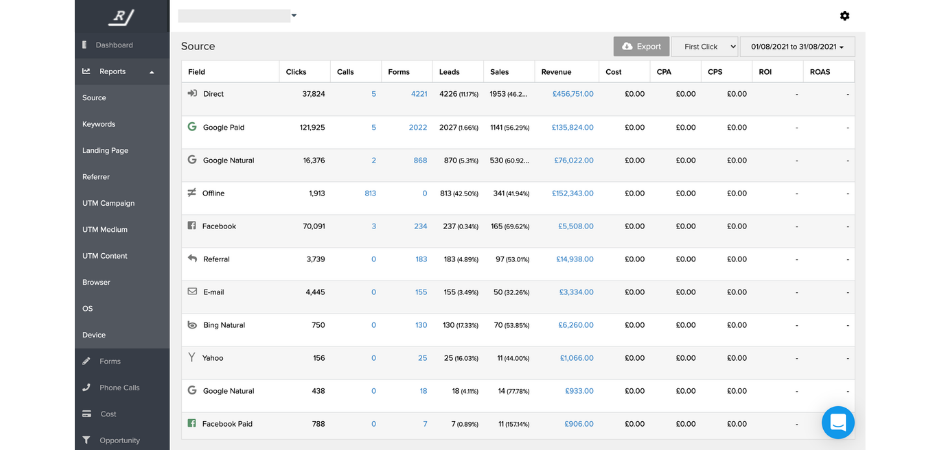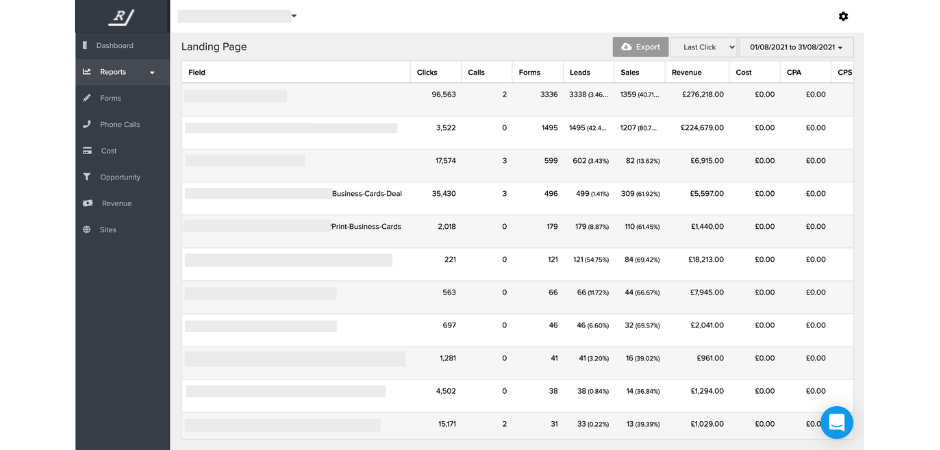Want to show your boss that marketing is driving business? We show you how we do it, plus how we increased our marketing sourced MRR too.
Monthly recurring revenue is a key stat for any business driving subscription-based sales.
Not only do you need to think about driving new business, but you also need to look at maintaining it too.
We all know that working in marketing isn’t easy.
You’re faced with a number of challenges that make it difficult to prove you’re doing a good job. And even more complicated, how you’re growing the business.
Luckily we’re here to help.
Retention and customer experience are key to driving long-lasting relationships with customers.
So, keep reading to learn exactly how we drove more marketing-source MRR and proved the marketing team was worth investing in.
Increasing MRR, even marketing sourced, isn’t just up to marketers.
For subscription-based businesses, customer experience is key. By driving long-lasting business you can not only ensure your retain revenue, but you can also encourage new business through case studies and reviews.
Before you start creating marketing campaigns and content, the first step is to get your sales and customer success team on board.
Remember, senior management will want to know exactly how you’re going to drive more business. And asking for more budget for PPC isn’t going to fly.
Instead, you need to take a targeted approach using data-driven decisions.
For us as a business, we knew we needed to activate projects between our sales, marketing and customer success teams.
For sales, it was a case of understanding what qualified a high-quality lead at the point of first contact. Was it their website? Their demographics?
For marketing, it was a case of linking our marketing to our sales. How many good-quality leads were we driving? And more importantly, what was driving revenue?
And lastly, for customer success, how were we keeping business? Churn is always a big risk factor for subscription-based companies, particularly those working in SaaS.
How could we identify churn-risk customers, or even better, identify customers at the point of sale who might churn down the line?
Action one was to meet as a full team and strategise on the moving parts each team was responsible for.
By ensuring we were aligned from the get-go, we ensured we had open and honest communication about what we needed to do as a team and individually.
It also allowed us to set expectations on what we could realistically achieve.
The best way to move forward is to first look back.
Nothing will tell you more than your historic data. Here’s exactly what we did to make better sense of our stats.
Let’s look into each in a bit more detail.
Look at your current customer data and segment them. Some will be high value and be a great fit for your product. As such, you could say they’re A-quality since you don’t want them to churn.
Meanwhile, you might find a particular type of customer churns more frequently. You could call these C-rated customers.
Our customer success team analysed all of our customers via this process. Once all of our customers were segmented, we applied churn and revenue data via ChartMogul.
It showed us that our A-rated customers were worth considerably more money per account and that they churned at a lower rate.
Meanwhile, our C-rated customers were much lower value and churned more despite support from our customer success team.
The marketing team took this data and used it to understand what made an A-level customer.
We found they tended to work in one of five major industries. We also found some patterns around things like job title, location and most importantly, referring source.
We were able to use this information to get a better understanding of what made a good customer. This allowed us to qualify our inbound leads with a little more certainty. We retrospectively applied lead quality data and moved on to the next stage of data analysis.
With an understanding of our top-quality leads, we were able to next look at trends in lead source when it came to generating A-rated leads.
We found clear patterns.
By using marketing attribution, we could accurately link our marketing activity back to leads and sales in our CRM.
Related: What is marketing attribution? A guide to models, tools and benefits
That left us with a clear view of what worked, and what didn’t.
Let us show you exactly how it worked.
Logging into our attribution tool, Ruler Analytics, we headed to our source report.

There, we could pinpoint trends.
We identified some channels that worked great at kickstarting customer journeys for A-rated leads. Meanwhile, we found others worked well at closing them.
There’s a lot of data at play here, so it’s important to break it down.
Here’s what this report helped us learn:
By analysing this data a little deeper, we can pull out a lot more information which helps us understand the role each channel plays.
And, most importantly, how we can optimise our strategy ahead.
We found a few things from our data analysis.
Organic SEO was our main driver of high-quality leads.
That wasn’t a surprise.
Our marketing team has been delivering high-quality, highly-ranked blog content on a regular basis.
But what was great was that we could further drill into this.
While it’s great to know organic SEO is working, isn’t it better to know which content pieces specifically?
We headed back into Ruler Analytics to pull our landing page report.

Here, we could see all the same information that we saw from a channel perspective. But this time it was split out by landing page.
Related: How we track landing page effectiveness at Ruler
That meant for every single blog we wrote, we could pinpoint how many clicks, leads and even sales they drove.
We found:
Each fact of data we got from this report was important.
It helped us to contextualise our content and understand the role our marketing played in the full customer journey.
Now we knew what was working, we were in a much better position to effectively plan ahead.
Of course, we have the benefit of having attribution at our disposal (at no cost).
We might be biased but we wholeheartedly recommend an attribution tool when you’re driving subscriptions and leads.
Tracking leads and connecting leads to sales is hard enough.
But creating a marketing strategy and accompanying marketing budget that will grow your business without this data, is nigh on impossible.
Anyway, here’s exactly what data we found and how we used it to transform our marketing and content strategy:
Let’s go into a bit more detail on what we did for each.
We knew what content was driving traffic, leads and sales. The exercise we did looking at landing page attribution had been really useful.
We could pinpoint content that is great at building traffic, great at creating leads and great at closing sales.
This exercise also gave us a clear indication of which blogs we needed to watch from a keyword perspective. Whether that was maintaining a high position or growing keyword positions, we had a much better sense of how our rankings affected our lead generation.
With all of this data in play, we created three content streams:
Since we had put the work in to grow our domain rating, we could now compete for much more difficult (and higher volume) keywords.
Related: How we grew our domain rating from 55 to 69
From here, we built keyword lists into new topics we wanted to cover that were more informative and educational.
These content pieces were us dipping our toe into new content clusters.
We wanted to drive more recognition between these content clusters and our brand name.
With our A-rated lead data, we could see which blogs and landing pages were driving high-quality leads.
We used this knowledge to create a priority list of content to maintain.
We also created a list of new content focused on new leads from our ‘traffic-building’ content list.
This is where we would explore content further down the funnel for new content clusters we were looking to explore.
Remember the content that created leads? Well, we used that to explore further down the funnel.
Let’s say for example a blog on ‘lead tracking software’ came up for generating leads.
We used that to look into bottom of the funnel content that would support that topic.
In this example, it would be content on ‘how our customer used Ruler to track their leads’ or comparison content between us and other named software on the list.
We knew the intent was there, so we built around what we knew already worked to help support that purchasing decision.
One thing that our data analysis illuminated was that brand awareness channels were working for us.
Our staff had started posting intermittently and some of our self-reported attribution data showed that it was working.
Related: Do you need a ‘how did you hear about us’ form field?
We wanted to capitalise on this as a new opportunity and so included it as a key part of our marketing strategy plan ahead.
Now, we’ve increased the frequency in which we post and we’ve got more employees feeling up to posting themselves. It’s all about confidence!
Another thing we noticed when analysing our content and channel data was that a lot of our A-rated leads were coming from referrals.
With Ruler in place, we could pinpoint what was driving these referrals.
One main one was G2.
Obviously, review sites are important for any SaaS business. But we felt there was a huge opportunity for us to grow our presence here since we hadn’t put any effort into collecting reviews.
Marketing and customer success now work together to provide quality service to customers who we then ask to share a review on site.
G2 offers more visibility the more good-quality reviews you have, so this was a big focus.
While we’re only making slow progress, we’ve already seen this impact our bottom line.
For us, 2020 and early 2021 was still about eBooks and lead generation.
We had managed to create a whole library of strong and useful resources and also drive MQL lead numbers up.
But it didn’t feel like it was working for us.
The data backed us up on that point.
We found that for us, organic, ungated content was working better to educate and inform our users.
But, instead of letting that good-quality content we had go to waste, we started translating it.
We’ve created blogs, videos, voice recordings and more to offer this content how people want to consume it.
And that’s working well.
We’re driving more meaningful engagement on our website by sharing the content people want, how people want it.
Improving your own MRR all starts with data and alignment between your teams.
There’s no point throwing money at campaigns and hoping it’ll stick.
You need to consistently prove that what you’re creating is working. And remember, the key is to always provide value.
We changed our marketing strategy so that we’re providing more value to our visitors and customers.
Instead of promoting ourselves, we’re trying to offer real-life advice and educate visitors on important insights.
Learn more from our experts by following us on LinkedIn. We share regular tips and tricks to make more out of your data and of your marketing.